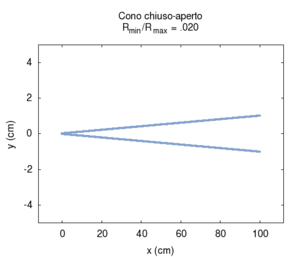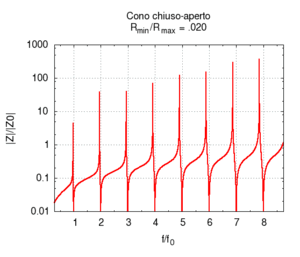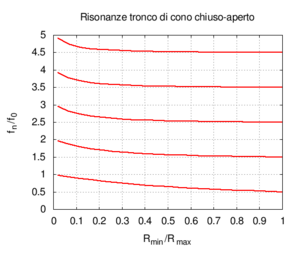Canna conica en
Da "Fisica, onde Musica": un sito web su fisica delle onde e del suono, acustica degli strumenti musicali, scale musicali, armonia e musica.
Jump to navigation Jump to searchEigenfrequencies and comparison with the cylindrical bore
The conical bore is the prototype of many wind instruments, such as the oboe, bassoon and saxophone. The trumpets, however, have almost cylindrical bores (except for a final bell), even though there are antique versions with conical bores. The latter can still be found as part of the pipes of most church organs.
The properties that make the conical bore a good candidate for constructing musical instruments are shown in the figure on the right and are the same that characterise the cylindrical bore:
- A conical bore has a fundamental frequency identical to an open cylindrical bore of the same length
- The upper order eigenfrequencies are in harmonic ratios with the fundamental
However, there are several important differences between cylindrical and conical bores; all due to the fact that, while wave fronts in cylindrical bores are plane, those in conical bores are spherical. The main consequence of this fact is perfectly intuitive:
- while a cylindrical bore is invertible; i.e. its throat and mouth can be switched without modifying its acoustic property, a conical bore is not. For example, a megaphone will not work if used in an inverted position.
In more precise terms, we can say that asymmetry derives from the fact that,
- while a plane wave front does not change its area during propagation, a spherical front increases its area by the square of the distance from the point of origin.
Consequently, sound is attenuated even in the absence of friction and dispersion simply due to the fact that sound energy coming from a source must be distributed in an area of space that gets wider as the wave advances. On the contrary, energy is concentrated into an increasingly smaller area for retrograde waves, this, for example, explains how the acoustic horn works. For this same reason, it is also true that,
- as opposed to what happens with plane waves, in the propagation within conical guides, a pressure node does not necessarily correspond to a speed anti-node or vice versa.
In the images that follow, we will study how the response of an open-open bore changes as the mouth size is progressively increased, while keeping the throat size fixed. Looking at the central image, we can see that the admittance maxima (i.e. the system resonances) are basically unchanged during the transformation. This fact again indicates that the initial cylindrical bore and all conical bores of the same length have the same resonances. However, we can clearly see that the frequency response changes from a symmetrical shape to an asymmetrical one. In between the maxima, the response of the cone is "distorted" with respect to the response of the cylinder and, in general, the anti-resonances are not found halfway between two resonances. Observing the rightmost image, we can see that the resonance frequencies remain substantially unvaried, except for the small deviations due to the greater radiation coming from very large mouths.
| Geometry | Acoustic response | Resonances |
|---|---|---|
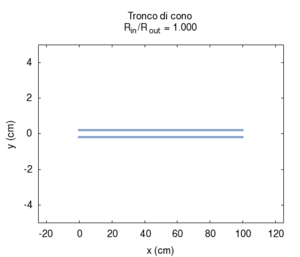
|
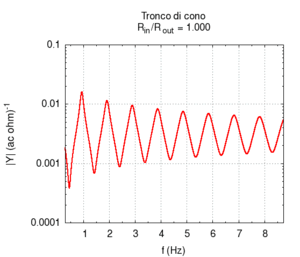
|
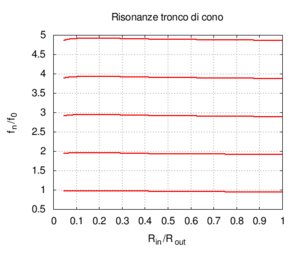
|
The paradox of the semi-closed bore
At first sight, we could think that, as a conical bore (i.e. open at both ends) has the same resonances as a open-open cylindrical bore, so a complete conical bore (with a closed end at the throat and an open mouth) is the same as a semi-open cylindrical bore. This is not so.
- The complete conical bore (i.e. closed-open) has the same resonance frequencies as an open-open cylindrical bore of equal length.
To understand this fact we need to examine the vibration mode in both cases. We can see that the sound pressure waves for each mode have nodes far apart by the same exact distance, which means that the wavelength (and in turn the frequency of vibration) is the same in the two bores, even if the mode shapes are different. Few animations of the modes of vibration of the bores can be found in the pages normal modes for a cylindrical bore, and normal modes for a conical bore. For an advanced study check the page wave equation in pipes.
| higher modes (nodal positions highlighted) | ||
|---|---|---|

|

|

|

|

|

|

|

|

|
This fact explains an important musical property of the clarinet, oboe and flute: even though the three instruments are about the same size (see the photograph on the left), the clarinet sounds an octave lower than the oboe, while the oboe and flute play within the same range. As a matter of fact, the clarinet has a cylindrical bore but its reed forces a pressure anti-node at the mouth, which makes it acoustically equivalent to a semi-closed bore (with regards to this, see the page Refraction in bores). On the contrary, the oboe has a conical body and, therefore, emits a fundamental with a wavelength equal to twice the length of the instrument and identical to that of the flute, which is an open-open cylinder. Therefore, the clarinet has a fundamental wavelength equal to about four times the length of the instrument and not two times like the oboe and flute. To be precise, we should say that the body of the clarinet is not really completely cylindrical but terminates with a conical bell that changes the response slightly (see the page Mixed bores for several examples that illustrate this phenomenon). However, this fact has no influence on the reasoning regarding the fundamental of the bore.
Animations for the modes of vibration of the bores can be found at the pages normal modes for a cylindrical bore, and normal modes for a conical bore. For an advanced study see wave equation in pipes.
Once again, this paradox is due to the spherical nature of the waves that propagate in the conical conduit, as opposed to the plane waves that travel in cylindrical conduits.












